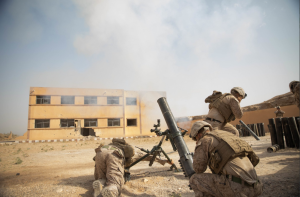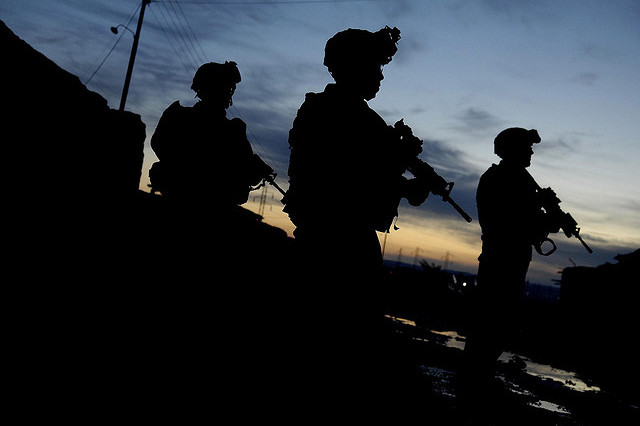by Diana Ohlbaum
“Between 2001 and 2017, U.S. government efforts to stabilize insecure and contested areas in Afghanistan mostly failed.”
Those are not my words. They’re not from some partisan pundit or ideological crusader. It’s the conclusion reached by the Special Inspector General who’s been investigating U.S. reconstruction efforts in Afghanistan for the past six years (SIGAR).
The failure of U.S. stabilization efforts, which ought to be patently obvious to any reasonable observer, is not lost on the agencies carrying them out. The State Department, Defense Department, and U.S. Agency for International Development (USAID) admit, in their recent Stabilization Assistance Review, “We cannot continue to take the same approach and expect different results.”
And yet, they continue to take the same approach. The U.S. government continues its military-led engagement in the world’s hot spots, privileging the transfer of arms, advice, and training to foreign security forces over the transfer of knowledge, skills, tools and opportunities to civilians. Programs to prevent violent extremism—such as strengthening dispute-resolution mechanisms, improving education and training, and expanding economic opportunity—take a back seat to counterterrorism training and ever-expanding secret wars.
One indicator of this civilian-military imbalance is that the United States doesn’t even have a clear or agreed definition of what is meant by “stabilization.” The mish-mash proposed by the three agencies above is almost laughable for its bureaucratic mumbo-jumbo that avoids resolving any of the key issues:
We define stabilization as a political endeavor involving an integrated civilian-military process to create conditions where locally legitimate authorities and systems can peaceably manage conflict and prevent a resurgence of violence.
If it’s a political endeavor, why does it need a military process? Has it not been repeatedly demonstrated that the U.S. military is unable to “create conditions” on the ground that lead to political stability? In most of these places, there are no “locally legitimate authorities and systems,” and the U.S. ends up trying to provide legitimacy to regimes that are corrupt, abusive, and inept. SIGAR reported that “disillusionment with formal governance was often based not on the government’s absence, but rather on its behavior when present.”
In fact, the order of the process is precisely the reverse: violence doesn’t stop until there is political legitimacy. The SIGAR study finds that “[t]he presence of local governance is a precondition for effective stabilization programming” and that trying to build and reform government institutions in the absence of local-level commitments to advance human security often fueled conflict and corruption.
Hence, outside assistance can succeed only where local partners demonstrate both the political will and at least a fledgling capacity to protect and serve the population. Successful U.S. policy depends on more than just “having a goal-oriented political strategy that aligns with local interests,” as the Stabilization Assistance Review proposes. The U.S. goal should be to support a locally driven political strategy.
So, if there are no locally legitimate authorities and no locally driven strategies deserving of U.S. support, should Washington stand by and do nothing?
The first thing the United States can do is avoid making the situation worse. For instance, selling arms and providing tactical support to Saudi Arabia while it carries out a campaign of indiscriminate civilian bombing in Yemen will only escalate and prolong the humanitarian crisis and fuel the desire for revenge against America. Arms sales and military assistance should be provided only when they advance legitimate and stable governance that respects and protects civilians.
The do-no-harm approach also means stopping endless war. Congress must repeal the 2001 and 2002 Authorizations for the Use of Military Force, which were intended to enable wars against al-Qaeda, the Taliban, and Iraq, but have been used to justify deployments, airstrikes, and other operations in at least 14 countries, including Djibouti, Eritrea, Ethiopia, Kenya, Libya, Philippines, Syria, and Yemen.
Second, the United States must fulfill its obligations under domestic and international law: to respect the right of all persons to seek asylum from persecution; to refrain from placing a refugee at risk of being returned to his or her country of origin; and to accord due process to undocumented migrants. America also has a moral duty to provide humanitarian assistance to those affected by conflict and violence.
Third, Congress should allocate more resources to international conflict prevention and peacebuilding activities. In Fiscal Year 2018, less than $4 billion was allocated to such programs, while more than four times as much—nearly $18 billion—went to military and police aid. That doesn’t even count the hundreds of billions in weapons sales and defense spending.
Finally, the administration should work to incorporate lessons from the Stabilization Assistance Review and a long list of SIGAR reports into current and future programming. Key among these is the recommendation to “carefully tailor all assistance and training programs in conflict-affected environments to ensure they mutually advance stability and do not inadvertently exacerbate conflict dynamics.” Congress could help by enacting legislation, such as the Global Fragility and Violence Reduction Act, to address the root causes of conflict and make violence-reduction programs more than a side note to U.S. global engagement.
Former Secretary of State Colin Powell did the world a great service by expounding his version of the “Pottery Barn Rule.” But “owning it” has proven considerably more difficult than he imagined. Now it’s time to quit breaking it.






This artaicle is so full of excellent, effective, and even compassionate advice, that it has zero chance of affecting the ‘Real World’ as presently understood by the US (and hangers-on).
And that, of course, is the entire problem.
Fantastic expense, and for what? Obama should have ended the US military adventure in Afghanistan
Every insurgency has an outside partner. How can we continue to help stabilize Afghanistan while Pakistan is destabilizing Afghanistan? I am confused. Please help me.
Diana, did anyone ever listen to you on those House and Senate Foreign Relations Committees?
Obviously not, you make too much sense.
Herman/Cohen want to expand the successful military-civilian political efforts to Pakistan. because it has worked out so well so far. well consider the source of that wisdom…